Trending
Opinion: How will Project 2025 impact game developers?
The Heritage Foundation's manifesto for the possible next administration could do great harm to many, including large portions of the game development community.

Featured Blog | This community-written post highlights the best of what the game industry has to offer. Read more like it on the Game Developer Blogs or learn how to Submit Your Own Blog Post
A summary of a GDC talk about one developer's experience on mobile with real data on iOS and Android.

I was hoping Chris Pruett would post a version of his talk, "Fact and Fiction: Lessons From Wind-Up Knight and Rise Of The Blobs" but he has not done so yet. The talk is available on the GDC Vault so if you attended GDC you can watch it there. It's only 23 minutes.
In it he attempted to break some common myths about iOS vs Android games. Of course this is just his experience but he made the point that most of the myths of iOS vs Android are not backed up by any data so he brought all his data.
I'm kind of hoping if I post this he'll feel compelled to post a version of his talk in his own words instead of mine. Hey Chris, Post your talk! In the meantime here's my summary of his talk
Chris said when we started his company, Robot Invader, he read everything he could about mobile development and all the collected wisdom. In fall 2011 they released Wind-up Knight, and in 2013 they released Rise of the Blobs. He read a lot of advice but none of them were backed up with data. So here's his data.
The theory being that iOS is where you make all your money and if it does really well you might be able to make a few extra bucks on an Android port.
Their experience was, Wind-up Knight is highly rated on all platforms they are on. So first off, this applies only to highly rated games. If your game is not highly rated maybe this won't fit. Second they decided to ship on Android first to do experiments, make sure they'd addressed user complaints before they ship on iOS. Also based on the advice from the net they thought iOS players are more likely to buy a paid game so they shipped free-to-play on Android but $0.99 on iOS.
What happened was they shipped in November 2011 on Android and it did amazingly well. They were featured by Google which was really awesome. They fixed a few issues and shipped the iOS version 1 month later. They were super lucky there too as they were featured by Apple. Not only that they were featured multiple times by both companies but on iOS they were featured during the Christmas Holiday season when Apple goes on vacation meaning their featured status says up for 2 weeks.
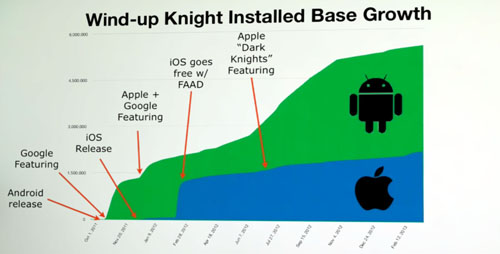
Looking at their data you can see as a paid app on iOS it didn't do well, even being featured. They made if free in February for a Free App a Day promotion and got over a million downloads but after that grown on iOS was never close to growth on Android. At the time of the talk they had 8 million players the vast majority on Android.
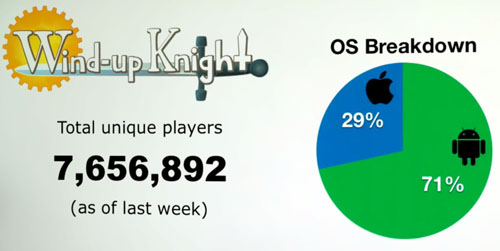
So what could they learn from that? Well one, they probably can't treat Android as a test platform to prep for iOS. On the other hand the apps were treated differently, one launched as free to play, the other has paid, so they couldn't really compare them.
On their second app, Rise of the Blobs, they did a simultaneous launch. They made it free-to-play on both platforms with in app purchases and it was highly rated on both platforms. On top of that, for the iOS version only they spent around $100k in advertising. The app was featured on both the Google Play store and the iOS App store for the same duration
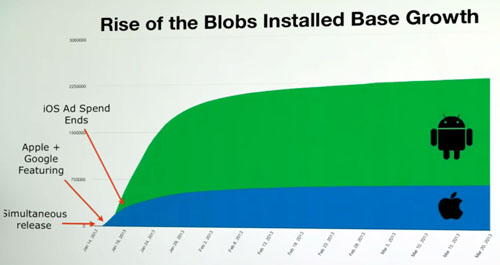
The result: They still did way better on Android in terms of user install numbers.
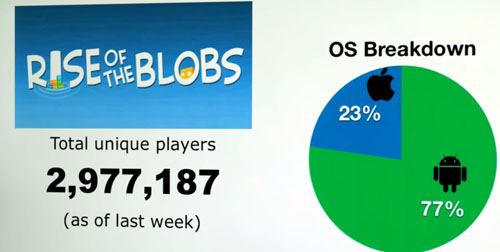
So in their opinion Myth #1 is is busted. It might have been true at one point but it's not true today.
Wind-up Knight shipped with English and Japanese only and here's how it did
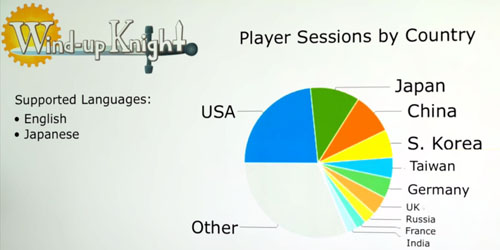
The majority of players were from the USA, Japan, and China and as for revenue almost all of it came from the USA and Japan. After Japan the next biggest was the UK and it was 4%
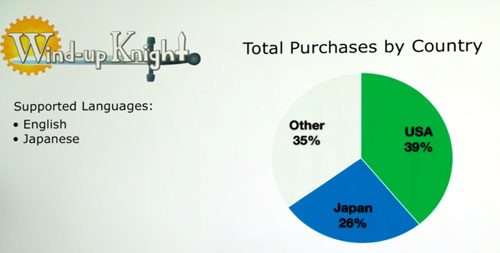
So, they thought maybe that was because they only localized for Japan as that's the only other country they made any good money from and if they localized to more languages they'd do way better in other countries.
So for Rise of the Blobs they localized to 7 languages and here's the result
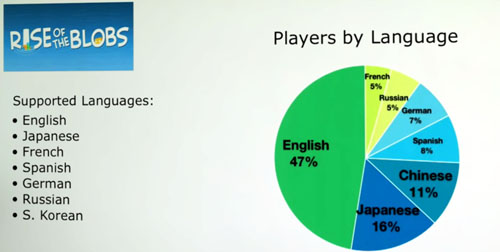
It's almost the same as it was before. A few counties came on. One thing to notice is they localized for Korean and yet Korea isn't even on the chart.

Looking at revenue it was still the same as before. All the money came from Japan and the USA. No other country accounted for more than 4%
So, from their POV this myth is busted. Apparently you only need to localize to Japanese. The other languages don't matter.
There could be many reasons for this. iOS is more expensive so those users have more money. Or maybe because you have to put your credit card into the iOS App Store it's easier to buy. Or maybe because there are extremely cheap Android phones those people don't have money to spend. These all reasons seem to make intuitive sense.
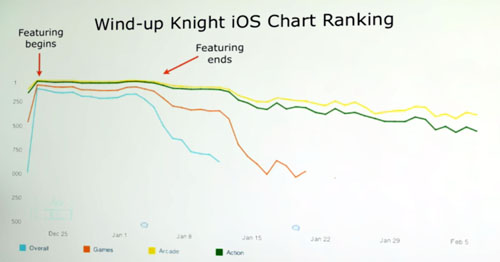
Looking at their iOS Chart ranking they had the same experience they've seen several other developers have which is that while they were featured their rank stayed high but as soon as it stopped being featured the ranking fell off a cliff. They feel like paid apps never did well on Android and their era on iOS may also be over. Once you fall off the ranking you're done unless you can spend $$$$$$ to bring it back up. The point here is that paid apps didn't make money on iOS so that's not a way to get more revenue vs Android.
People believe that iOS users will still spend more than Android users if the app is free-to-play with in app purchases but that's not what they found.
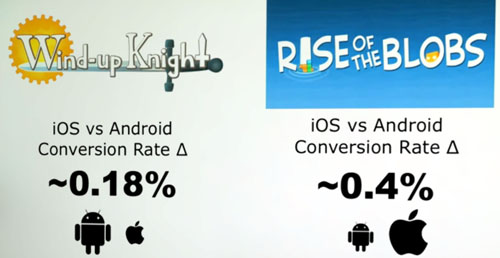
The rates are basically the same for both platforms. Behavior of users on both platforms for the same game is the same. Clearly since they have more users on Android their making more money on Android.
Myth busted
Trying to figure out if this myth is true they looked at session length. For Rise of the Blobs iOS users play about twice as long as Android users. Not just iPad users but all iOS users.

For Wind-up Knight iOS users play almost 3x Android users
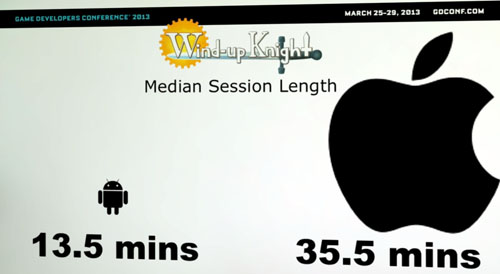
Even stranger, when it was a paid app iOS users played for an AVERAGE of hour per session.

That's AVERAGE session! WTF! He thought maybe that's because a lot of iOS users were on iPad but that's not the case

iPhone users play longer than iPad users. So, I guess the Myth, that iPad users play different, is true but not in the way most people think.
They develop in Unity3D and had almost zero problems. Of 1970 devices they only had trouble with 3 devices. 2 of which were a market issue they couldn't work around but that were solved by a Google Play update so they only had to make a special workaround for 1 device that had a GPU driver issue.

So in their opinion this Myth is busted.
But, they did want to mention that it's more a of a pain to support Android users because of the way the markets are set up. On iOS if you want a refund you talk to Apple. On Android if you want a refund you talk to the developer. Over their entire life so far they've had 316 support requests from iOS and 4170 Android requests. Things like "my kid bought $300 of stuff in your game and I didn't know there was a parental lock built into the phone".
They were told their games would fail because they are hard.
They don't believe this is true. They have super fans that have cleared their games and they post screenshots and become their biggest promoters.
They're not saying a more casual game won't get more users. Just that there is a market for hard games.
So that's my summary of Chris's talk.
I think #5, fragmentation, might have been a much bigger problem 3+ years ago. At that time there were devices with single touch, devices with a trackball, devices with keyboards, etc... Now pretty much all devices are a single multi-touch screen with no extras. On top of that, at least for Rise of the Blobs, it's a 1 finger game and it doesn't matter where you put your finger. That would seem to have at least a minor influence. Wind-up Knight is a 2 button game. I'm only guessing that games with virtual joypads might have more issues but then I have no idea since I haven't made a game.
The fact that iOS users are playing 2-3x more than Android players suggests a place for more data. Do they actually play different or is there a bug in the tracking? Android's are multi-tasking so maybe users switch in and out of a game and something that looks like 2 sessions is actually 1? Does Chris's metrics merge sessions that are under a say 15 minutes apart? On other hand, if iOS users do play more you'd expect them to spend more on the types of games that have consumables since more play equals consuming more consumables so YMMV.
I'm sure you might have opinions on this as well. I think rather than argue about it it's just good to see this counter example to the common wisdom. Maybe if you're getting different results you're not doing something that Robot Invader is and you could do much better if you were or visa-versa, maybe if they were doing something similar to you they'd get results similar to yours.
PS: This article was originally posted at http://games.greggman.com/game/android-vs-ios-game-myths/.
Read more about:
Featured BlogsYou May Also Like